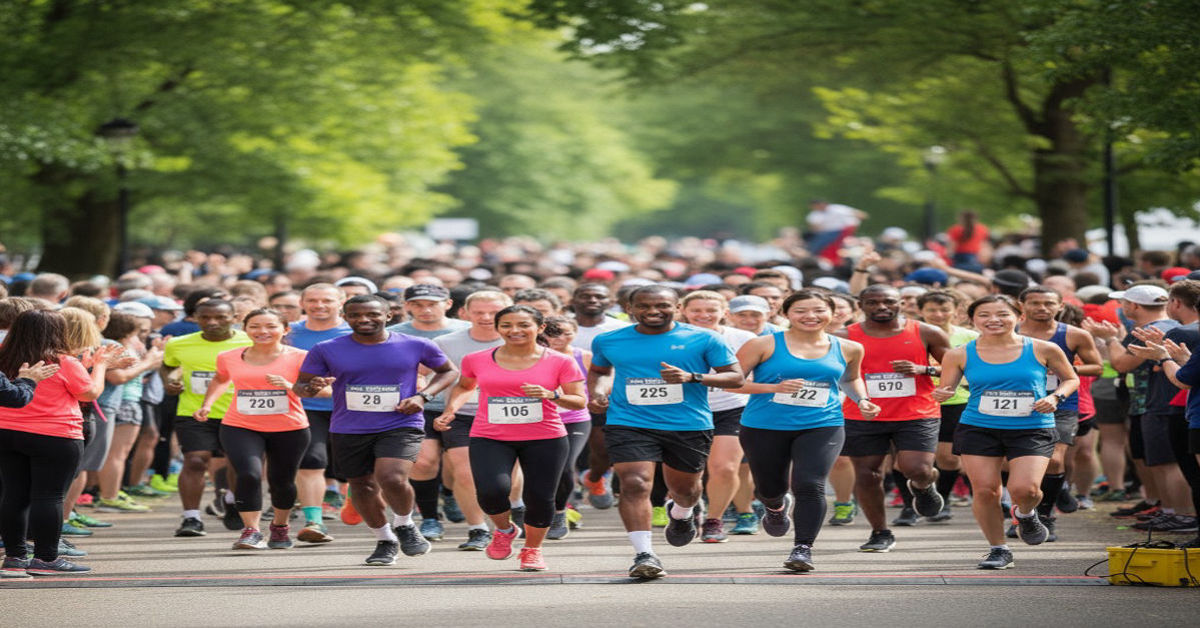Are you ready to lace up your running shoes and take the plunge into the exhilarating world of races? If you’re wondering how long is a 5K, you’re in for an exciting journey. A 5K or 3.1 miles is often considered the perfect distance for beginners. It strikes that ideal balance between challenge and accessibility, making it a popular choice for newcomers and seasoned athletes alike.
Whether you’re aiming to achieve a personal best or simply want to cross the finish line, preparing for your first race can be both thrilling and daunting. With some guidance on physical prep, training schedules, nutrition tips, gear essentials, and common pitfalls to avoid along the way—you’ll feel confident tackling those streets come race day! Let’s dive into everything you need to know about conquering your very first 5K.
What is a 5K?
A 5K is a running race that covers a distance of 3.1 miles, making it the go-to event for many first-time participants. It’s short enough to be accessible but long enough to provide a satisfying challenge.
Races can take place on various terrains—roads, trails, and even tracks. You’ll often find them organized as charity events or community gatherings, bringing together runners of all ages and skill levels.
The popularity of the 5K has surged in recent years due to its inviting nature. It serves as an excellent introduction for those looking to dip their toes into competitive running without feeling overwhelmed by longer distances.
From casual joggers to serious competitors, everyone finds their place at the starting line. So if you’re thinking about joining a local race, you’re making an exciting choice!
Benefits of Running a 5K
Running a 5K offers numerous benefits, both physical and mental. For many, it’s an achievable distance that encourages newcomers to lace up their sneakers.
The challenge of training builds endurance and strength. Over time, you’ll notice improved cardiovascular health and increased stamina. This can lead to better performance in other sports or fitness activities.
Mentally, crossing the finish line provides a significant sense of accomplishment. It boosts confidence and motivates individuals to set new goals.
Socially, participating in local races fosters community connections. You meet fellow runners who share your passion for fitness.
Additionally, running can help reduce stress levels and improve mood through the release of endorphins. Engaging regularly with this activity promotes healthier lifestyle choices overall.
Whether you’re aiming for personal bests or simply enjoying the journey, participating in a 5K is rewarding on multiple fronts.
Physical and Mental Preparation for a 5K
Preparing for a 5K involves both physical and mental aspects. Start with a solid training routine to build your stamina. Incorporate running, walking, or jogging several times a week. Gradually increase your distance to avoid injury while enhancing endurance.
Mental preparation is just as crucial. Visualize yourself crossing the finish line successfully. This positive imagery can boost confidence and reduce race-day anxiety.
Practice mindfulness techniques like deep breathing or meditation during training sessions. This will help you stay focused when nerves kick in on race day.
Don’t underestimate the importance of setting realistic goals for your first 5K. Celebrate small milestones along the way; these achievements keep motivation high and spirits lifted.
Connect with fellow runners through groups or online forums for support and encouragement leading up to the event. Building camaraderie can elevate your experience, making it not just about running but also about community engagement.
Training Schedule for Beginners
Creating a training schedule for your first 5K is crucial. Start with a solid foundation. Aim to run three times a week, allowing rest days in between to recover.
Begin with a mix of walking and running. For example, alternate 1 minute of running with 2 minutes of walking. Gradually increase the running intervals as you become more comfortable.
As you progress, extend your long run on weekends. This builds endurance and helps prepare your body for the distance ahead.
Incorporate strength training twice weekly too. Simple exercises like squats and lunges can enhance your performance without adding excessive strain.
Remember to listen to your body throughout the process. If something doesn’t feel right, take it easy or adjust your plan accordingly. Consistency is key; celebrate small victories along the way!
Nutrition and Hydration Tips for Race Day
On race day, fueling your body is crucial. Start with a balanced breakfast that includes carbohydrates and protein. Oatmeal with fruit or a bagel with peanut butter are excellent choices.
Stay hydrated in the hours leading up to the race. Drink water consistently but avoid overhydration, which can lead to discomfort during your run.
Consider incorporating electrolyte drinks if you expect warm weather or plan on running for an extended period. Hydration packs or handheld bottles can be handy if you’re concerned about finding water stations along the route.
During the race, listen to your body’s signals. If you feel thirsty, take small sips from available hydration stations without stopping too long in one place.
Post-race recovery also matters; refuel within 30 minutes after finishing by having a snack rich in carbs and protein to help replenish energy levels properly.
Essential Gear for Running a 5K
Choosing the right gear can significantly impact your 5K experience. First and foremost, invest in a quality pair of running shoes. Look for ones that offer good support and cushioning, tailored to your foot type.
Comfortable clothing made from moisture-wicking fabrics is essential too. Avoid cotton, as it traps sweat and causes chafing. Opt for lightweight shorts or leggings paired with a breathable shirt.
Don’t forget accessories like sunglasses and a hat to shield you from the sun on race day. A well-fitted sports watch can help track your pace, distance, and time during training.
Consider hydration solutions such as handheld water bottles or belt packs. Staying hydrated keeps your energy levels up during the race. Pay attention to these details—they’ll make all the difference when you’re out on the course!
Common Mistakes to Avoid During a 5K
Many first-time runners make the mistake of starting too fast. Adrenaline can be tempting, but conserving energy is crucial for a successful finish.
Another common misstep is neglecting proper warm-ups and cool-downs. These routines help prevent injuries and aid recovery, making them essential parts of your race strategy.
Ignoring hydration in the days leading up to race day can also hinder performance. Ensure you’re well-hydrated to avoid cramps or fatigue during the event.
Wearing new shoes on race day is risky. Stick with familiar gear that has been tested through training runs to avoid discomfort.
Don’t underestimate the importance of pacing yourself throughout the course. Keeping a steady pace helps maintain stamina and allows for an enjoyable experience from start to finish.
Cross-Training Exercises to Improve Your 5K Performance
Cross-training can significantly enhance your 5K performance. It helps build strength, endurance, and flexibility without the repetitive impact of running.
Cycling is a great option. It works your leg muscles while giving them a break from pounding the pavement. Plus, it boosts cardiovascular fitness.
Swimming is another fantastic choice. The resistance of water engages multiple muscle groups and improves lung capacity. It’s also low-impact, making it easy on joints.
Yoga promotes flexibility and core stability. This balance can improve your running form and reduce injury risk.
Strength training shouldn’t be overlooked either. Focusing on legs, core, and upper body will help increase power during races.
Incorporating these exercises into your routine ensures you’re not only prepared for race day but are also developing well-rounded athleticism that enhances overall performance.
Recovering from Your First 5K
Recovering from your first 5K is just as important as training for it. After crossing that finish line, your body needs time to heal and adapt.
Start with gentle stretching to ease tight muscles. Focus on areas like your calves, hamstrings, and quadriceps. This helps release tension built during the race.
Hydration plays a crucial role in recovery too. Drink plenty of water or electrolyte drinks to replenish what you lost while running.
Consider light activity in the days following the race. Walking or easy cycling can keep blood circulating without putting too much strain on your body.
Listen to how you feel; don’t rush back into intense workouts immediately. Rest when needed, and give yourself permission to enjoy this achievement before diving back into training routines again.
Celebrate your accomplishment! Enjoy some downtime before setting new goals for future races.
Conclusion
Completing a 5K is an achievable goal that can bring immense satisfaction and personal growth. Understanding how long a 5K is—3.1 miles—sets the stage for your journey. The benefits of participating extend far beyond just physical fitness; they encompass mental resilience and community engagement as well.
Prepare yourself physically and mentally by following a structured training schedule tailored for beginners. Fuel your body adequately with proper nutrition and hydration strategies leading up to race day, ensuring you feel strong when it counts most.







